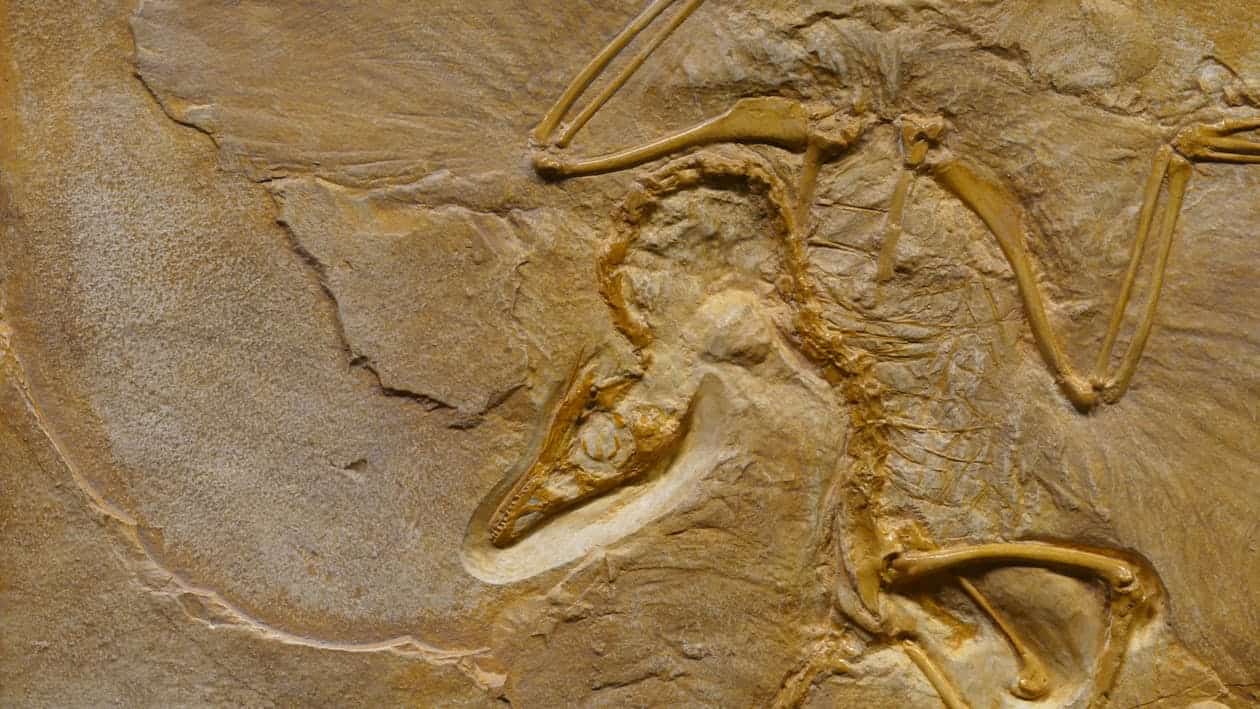[2024] 70+ Free Online Courses on Evolutionary Science
These free courses cover all facets of evolutionary science, including biology, genetics, and paleontology.

The history of science is long and full of important milestones. But few are as profoundly impactful of the realisation that all living things share a common ancestor. Evolutionary science draws from all branches of biology — from genomics to paleontology — to explain the mechanisms of evolution.
In this article, we’ve leveraged the Class Central database of over 200k courses to compile more than 70 online courses on evolution and its different facets. The courses are all free or free-to-audit, meaning you’ll have access to all the learning content.
To make the list easy to navigate, we’ve broken it down by subject. Click on a subject to jump to the corresponding courses:
Evolution: An Unusual Journey
You may recall that whales are mammals. But did you know about their unusual journey? Their ancestors migrated from the sea to land, developing lungs and hip bones, among others. Then, they migrated back to the sea. Thus, whales are more closely related to hippos than to anything that lives in the sea!
All life on earth is related, it is just a matter of degree. Evolutionary science studies this relationship, and it has led to fascinating discoveries — did you know that some dinosaurs had feathers?
Additionally, evolutionary biology is increasingly being used in other fields, from public health to psychology and anthropology, to generate rich hypotheses.
If you’re interested in learning more, you’ll find a selection of great courses below. So satisfy your curiosity and get your evolutionary science on!
More Courses
And if you don’t find what you need here, or if you already know all there is to know about evolution (is that even possible?), have a look at our other collections of scientific courses:
- 900 Free Computer Science Courses from World’s Top Universities
- 650+ Physics Online Courses You Can Take for Free
- 200 Chemistry Courses to Expand Your Knowledge of the World
- 120+ Math Online Courses from the World’s Top Universities
- 100+ Free Online Courses and Webinars on AI in Healthcare
And you can find all our free certificate compilations here.
General Evolution Online Courses
Introduction to Genetics and Evolution
Duke University via Coursera
This course provides the basic biology you need to understand all of these issues better, tries to clarify some misconceptions, and tries to prepare students for future, more advanced coursework in Biology (and especially evolutionary genetics).
★★★★★ (31 ratings)
Origins – Formation of the Universe, Solar System, Earth and Life
University of Copenhagen via Coursera
The Origins course tracks the origin of all things – from the Big Bang to the origin of the Solar System and the Earth. The course follows the evolution of life on our planet through deep geological time to present life forms.
★★★★★ (7 ratings)
Super-Earths and Life
Harvard University via edX
Learn about the Earth, life, and how we can search for life elsewhere in the universe.
★★★★☆ (5 ratings)
Evolution: A Course for Educators
American Museum of Natural History via Coursera
How are all of the species living on Earth today related? How does understanding evolutionary science contribute to our well-being? In this course, participants will learn about evolutionary relationships, population genetics, and natural and artificial selection. Participants will explore evolutionary science and learn how to integrate it into their classrooms.
★★★★★ (2 ratings)
Evolution Today
Leiden University via Coursera
In this course you will learn how evolution works. You will develop an understanding of evolutionary processes and their formative power. You will see how evolution has shaped biodiversity, and continuously influences our daily life. Evolution impacts human endeavors as varied as medicine, agriculture, psychology, economy, and culture.
★★★★★ (2 ratings)
Understanding and Teaching Evolution
University of Bath via FutureLearn
Learn key concepts in biological evolution and find out how to integrate them into the classroom.
★★★★★ (1 rating)
Emergence of Life
University of Illinois at Urbana-Champaign via Coursera
How did life emerge on Earth? How have life and Earth co-evolved through geological time? Is life elsewhere in the universe? Take a look through the 4-billion-year history of life on Earth through the lens of the modern Tree of Life! This course will evaluate the entire history of life on Earth within the context of our cutting-edge understanding of the Tree of Life.
★★★★★ (4 ratings)
The Big Stuff: Evolution and Ecology
University of Colorado Boulder via Coursera
In this course, we will explore how evolution works to generate new species, the wide variety of life on earth. We will also touch on the importance of biodiversity for the overall health of our planet, and for our well being as humans. Then we will discuss ecology and the interconnectedness of life and touch on one big ecological issue in today’s society, conservation.
Introduction to Biology: Evolution
Rice University via Coursera
Evolution is one of the most interesting fields within biology, and one that’s central to a complete understanding of modern biology. We begin by tracing how Charles Darwin developed a theory of evolution by natural selection and the many ways that biologists have advanced the science of evolution since his lifetime. We then go on to learn about the many applications of evolutionary biology to our everyday lives.
Evolution through natural selection
The Open University via OpenLearn
In this free course, Evolution through natural selection, we describe the theory of evolution by natural selection as proposed by Charles Darwin in his book, first published in 1859, On the Origin …
★★★★★ (1 rating)
Natural Selection and Evolution
Shomu’s Biology via YouTube
Evolution: artificial selection and domestication
The Open University via OpenLearn
In the 18th and 19th century evolutionary biologists, including Darwin, emphasised the similarities between natural evolution and artificial ‘improvement’ of livestock under domestication.
Evolution Examples
via YouTube
The science of evolution
The Open University via OpenLearn
This free course, The science of evolution, debates the issues surrounding the science of evolution and religion.
生物演化
Peking University via Coursera
本课程以达尔文的“自然选择”和“生命之树”为主线,将重点介绍达尔文演化理论的要点,以及后人对达尔文理论的修订、补充和完善;介绍一些推动生物演化的主要力量,如遗传变异、自然选择、中性选择、遗传漂变等。同时还将介绍生物演化研究领域的各种方法和技术,并在此基础上通过很多实例对从远古的化石到现今多姿多彩的生物世界、从生物的形态改变到遗传物质的变化、从生物分子的起源到人类的起源等现象和问题进行解释。本课程将以大量的事实告诉大家:生物演化不仅仅是理论,而且是事实,它就发生在我们的身边。
The Tail of a Mosasaur – A Window on the Tempo and Mode of Evolution in Aquatic Tetrapods
Royal Tyrrell Museum of Palaeontology via YouTube
The Early Evolution of Dinosaurs
Thomas Evans via YouTube
Information, Evolution, and Intelligent Design – With Daniel Dennett
The Royal Institution via YouTube
Studying Darwin
The Open University via OpenLearn
Please note that this is not a course containing teaching materials. It collates links to a variety of courses and other resources about natural selection, its relevance to different environments …
Darwin and Design (Fall 2010)
Massachusetts Institute of Technology via MIT OpenCourseWare
This course covers social development, social behaviour, social cognition and social neuroscience, in both human and non-human social animals.
Biology & Chemistry Online Courses
Introduction to Biology – The Secret of Life
Massachusetts Institute of Technology via edX
Explore the secret of life through the basics of biochemistry, genetics, molecular biology, recombinant DNA, genomics and rational medicine.
★★★★★ (146 ratings)
Principles of Biochemistry
Harvard University via edX
This introduction to biochemistry explores the molecules of life, starting at simple building blocks and culminating in complex metabolism.
★★★★★ (12 ratings)
Bioinformatic Methods I
University of Toronto via Coursera
Large-scale biology projects such as the sequencing of the human genome and gene expression surveys using RNA-seq, microarrays and other technologies have created a wealth of data for biologists. However, the challenge facing scientists is analyzing and even accessing these data to extract useful information pertaining to the system being studied.
★★★★☆ (9 ratings)
Tales from the Genome
23andme via Udacity
This course is a journey into the biology of the human genome and will highlight the scientific, social, and personal perspectives of people living with a variety of traits.
★★★★★ (7 ratings)
Introduction to Systems Biology
Icahn School of Medicine at Mount Sinai via Coursera
Learn about Systems Biology, focusing on mammalian cells and their functions. Understand how molecules interact to form functional systems and how emergent behaviors arise. Develop skills in experimental design, data analysis, and quantitative reasoning.
★★★★☆ (5 ratings)
Bioinformatic Methods II
University of Toronto via Coursera
Large-scale biology projects such as the sequencing of the human genome and gene expression surveys using RNA-seq, microarrays and other technologies have created a wealth of data for biologists. However, the challenge facing scientists is analyzing and even accessing these data to extract useful information pertaining to the system being studied.
★★★★☆ (4 ratings)
Introductory Biology (Spring 2005)
Massachusetts Institute of Technology via MIT OpenCourseWare
The course focuses on the application of fundamental principles, toward an understanding of microorganisms as geochemical agents responsible for the evolution and renewal of the biosphere and of their role in human health and disease.
★★★★★ (3 ratings)
The Extremes of Life: Microbes and Their Diversity
Kyoto University via edX
Microbes are everywhere! Find out how diverse microbial life is, and what their genome sequences tell us.
★★★★☆ (2 ratings)
AP® Biology – Part 3: Evolution and Diversity
Rice University via edX
The third course in a comprehensive series designed to prepare you for the AP Biology exam, focusing on evolution and diversity.
DNA: Biology’s Genetic Code
Rice University via edX
DNA carries the defining data for life in a simple genetic code that comes with its own “back-up” system. Explore DNA structure with us!
Foundations of Computational and Systems Biology (Spring 2014)
Massachusetts Institute of Technology via MIT OpenCourseWare
This course is an introduction to computational biology emphasizing the fundamentals of nucleic acid and protein sequence and structural analysis.
Molecular Evolution (Bioinformatics IV)
University of California, San Diego via Coursera
In the previous course in the Specialization, we learned how to compare genes, proteins, and genomes. One way we can use these methods is in order to construct a “Tree of Life” showing how a large collection of related organisms have evolved over time.
Protists: Evolution and Ecology of Microbial Eukaryotes
Saint Petersburg State University via Coursera
Life on Earth appears to be dominated by higher plants and animals. Yet an immense variety of microbial eukaryotes swarm in the foliage, grass, soil, bogs, ponds, streams, lakes, and oceans. These inconspicuous organisms are flagellates, algae, ciliates, sarcodines, slime molds, apicomplexans. This assemblage is generally termed the protists.
Heredity and Evolution Biology – CBSE Class 10
via YouTube
You will learn about inherited traits, Mendel’s experiment, dominant and recessive traits, chromosomes, homologous and heterologous chromosomes, principles of inheritance, evolution, speciation, evidence of evolution, human evolution, and much more.
Computational Molecular Evolution
Technical University of Denmark (DTU) via Coursera
In this course you will learn about how and why DNA and protein sequences evolve. You will learn the theory behind methods for building and analyzing phylogenetic trees, and get hands-on experience with some widely used software packages.
★★★★☆ (4 ratings)
Evolution
via YouTube
MIT Computational Biology – Genomes, Networks, Evolution, Health – Fall 2018
Massachusetts Institute of Technology via YouTube
Life Science and Biology Year in Review – Cells, Genetics, Evolution, Symbiosis, Biomes, Classification
MooMooMath and Science via YouTube
★★★★★ (1 rating)
Can Evolution Be Understood Quantitatively? by Daniel Fisher
International Centre for Theoretical Sciences via YouTube
Population Genetics and Evolution – I- The Mechanisms of Evolution
International Centre for Theoretical Sciences via YouTube
Tracking Short-Term Evolution in a Pedigreed Wild Population
EvoEcoSeminars via YouTube
Statistical Physics of Biological Evolution by Joachim Krug
International Centre for Theoretical Sciences via YouTube
Modelling the Role of the Microbiome in Evolution
Santa Fe Institute via YouTube
Paleontology & Geology Online Courses
Dino 101: Dinosaur Paleobiology
University of Alberta via Coursera
Dino 101: Dinosaur Paleobiology is a 12-lesson course teaching a comprehensive overview of non-avian dinosaurs.
★★★★★ (155 ratings)
Paleontology: Theropod Dinosaurs and the Origin of Birds
University of Alberta via Coursera
Paleontology: Theropod Dinosaurs and the Origin of Birds is a five-lesson course teaching a comprehensive overview of the origins of birds. This course examines the anatomy, diversity, and evolution of theropod dinosaurs in relation to the origin of birds.
★★★★★ (49 ratings)
Paleontology: Ancient Marine Reptiles
University of Alberta via Coursera
Paleontology: Ancient Marine Reptiles is a four-lesson course teaching a comprehensive overview of the evolutionary changes that occur when air-breathing terrestrial animals return to water. This course examines the diversity, adaptations, convergence, and phylogenetic relationships of extinct marine reptiles. Students will explore three major groups of marine reptiles: ichthyosaurs, plesiosaurs, and mosasaurs. Watch a preview of the course here: https://uofa.ualberta.ca/courses/paleontology-marine-reptiles
★★★★★ (32 ratings)
Paleontology: Early Vertebrate Evolution
University of Alberta via Coursera
Paleontology: Early Vertebrate Evolution is a four-lesson course teaching a comprehensive overview of the origin of vertebrates. Students will explore the diversity of Palaeozoic lineages within a phylogenetic and evolutionary framework. This course examines the evolution of major vertebrate novelties including the origin of fins, jaws, and tetrapod limbs. Students also explore key Canadian fossil localities, including the Burgess Shale (British Columbia), Miguasha (Quebec), and Man On The Hill (Northwest Territories). Watch a preview of the course here: https://uofa.ualberta.ca/courses/paleontology-vertebrate-evolution
★★★★★ (30 ratings)
The Dynamic Earth: A Course for Educators
American Museum of Natural History via Coursera
The AMNH course The Dynamic Earth: A Course for Educators provides students with an overview of the origin and evolution of the Earth. Informed by the recently released Next Generation Science Standards, this course examines geological time scales, radiometric dating, and how scientists “read the rocks.” We will explore dramatic changes in the Earth over the last 4 billion years, including how the evolution of life on Earth has affected its atmosphere.
★★★★☆ (3 ratings)
Dinosaur Ecosystems | 恐龙的生态系统 | Los Ecosistemas de los Dinosaurios
The University of Hong Kong via edX
A global adventure to learn how palaeontologists use animal and plant fossils as well as living forms to reconstruct dinosaur ecosystems. 一个环球的探索,了解古生物学家如何运用动植物化石以及现存生物来重建远古恐龙的生态系统。Una aventura global para aprender cómo los paleontólogos utilizan fósiles de animales y plantas, así como organismos vivientes, para reconstruir los ecosistemas en donde vivían los dinosaurios。
★★★★★ (3 ratings)
Vertebrate Paleontology
Utah State University via YouTube
★★★★★ (2 ratings)
Extinctions: Past, Present, & Future
Emory University via Coursera
This course introduces you to the five mass extinctions of the pre-human past, their causes and significance to the history of life on earth, and the current mass extinction happening during our time. We’ll also explore the history of paleontoloigical and geological study and review the key players that influenced the science today. Regardless of your familiarity with the topic, you’ll get portable handouts, lively demonstrations, and quizzes that bridge and enhance your knowledge.
★★★★☆ (1 rating)
Life on Land: Ecology, Evolution, Challenges, and Solutions
University of the Sunshine Coast via FutureLearn
Discover the human impact on terrestrial ecosystems, biodiversity, and animals as you learn how to protect life on land.
Invertebrate Paleontology and Paleobotany
Utah State University via YouTube
Natural History of Dinosaurs
via YouTube
Fossils and Geology
via YouTube
Morphology, Disparity, and Evolution of Theropod Teeth in the Late Cretaceous in Alberta
Royal Tyrrell Museum of Palaeontology via YouTube
Tyrants of the Cenozoic: Evolution of Bone-Crushing Hyenas and Dogs
Royal Tyrrell Museum of Palaeontology via YouTube
A Big Step for a Fish – The Evolution of Four-Legged Land Animals
Royal Tyrrell Museum of Palaeontology via YouTube
Echinoderms – Invertebrate Paleontology – Crinoids, Starfish, Sand Dollars, & More
GEO GIRL via YouTube
Late Ice Age Mammals on Vancouver Island
Royal Tyrrell Museum of Palaeontology via YouTube
Vertebrate Evolution I
Thomas Evans via YouTube
Human Evolution Online Courses
Introduction to Human Evolution
Wellesley College via edX
Explore human evolutionary history through the human fossil, archaeological and genetic records.
★★★★★ (8 ratings)
Evaluating Animal Breeding Programmes
Wageningen University via edX
Learn how to evaluate an ongoing breeding programme in terms of both genetic progress and genetic diversity, and how to translate that genetic progress from the breeding programme to the farmer’s work.
The Future of Human Evolution – What Darwin Didn’t Know
Wondrium via YouTube
★★★★☆ (1 rating)
Bipedalism: The Science of Upright Walking
Dartmouth College via edX
Upright walking is a hallmark of being human. Explore how this unusual form of locomotion evolved and why.
Neogene Life and Human Evolution from Early Apes to Australopithecus to Homo
GEO GIRL via YouTube
Charles Darwin: El origen del evolucionismo moderno
Universidad Nacional Autónoma de México via Coursera
Este curso está dirigido a cualquier persona que desee conocer de manera general qué es y cómo se ha explicado la evolución de las especies. Será de gran interés para alumnos, profesores y profesionales del área de ciencias biológicas y de la salud que deseen conocer los antecedentes históricos, así como los fundamentos centrales de la teoría de Charles Darwin, que configuraron el pensamiento evolutivo moderno.

Rui Ma








Daryl Aldridge
Do all colleges and universities accept the courses for transfer
Manoel Cortes Mendez
No, the courses in this article are free to audit, but don’t include a free certificate nor academic credit. Few courses can lead to academic credit, and in my experience, those are never entirely free.